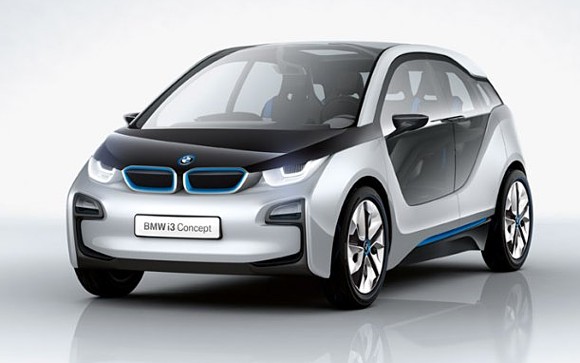BMW has begun the process of bringing together the channels that will bring the Model i3 to mass production for the consumer market.
 BMW i3 exterior view. Image courtesy of BMW.
BMW i3 exterior view. Image courtesy of BMW.
Promoted by the company as being “specifically developed for use in an urban environment,” the BMW i3 concept car has been built to run purely on electric power with an electric motor over the rear axle that can generate an output of 125 kW/170 hp and a torque of 250 Nm (184 lb-ft) from a standstill position.
As far as speed, the concept car can go from 0-60 km/h (37 mph) in under four seconds and 0-100 km/h (62 mph) in under eight seconds.
Also among the specs, the company says that the single-speed gearbox provides “optimal power transmission to the rear wheels and accelerates” the car to an electrically governed speed 150 km/h (93 mph) without loss of power.
As for the physical size of the motor, the company says, “The space requirements of the electric motor used in the BMW i3 Concept have been reduced by 40 percent compared with the motor used in the MINI E. This compact drive unit is mounted over the rear axle, together with the power electronics, transmission and differential, and does not intrude on the interior.”
In addition, a newly developed technology in the industry has also been incorporated into the car’s accelerator pedal.
As the company explains, “After the driver eases up on the accelerator, the electric motor acts as a generator, converting the kinetic energy into electricity, which is then fed back into the battery.”
The power needed to drive the vehicle and operate all of its functions is supplied by the lithium-ion battery cells.
The battery can be fully recharged in about six hours at a standard power socket, and if a high speed charger is used, an 80 percent charge can be achieved in less than an hour.
The company says that, “In order to ensure the greatest possible electric range, the battery in the BMW Concept is correspondingly large. The most space-efficient place to store the battery cells is in the car’s underfloor section, where they occupy the whole of the module’s central section, giving the car optimum weight distribution and a low center of gravity.”
BMW continues that, “The battery is penned in by aluminum profiles, which protect it from external impacts. Crash-active structures in front and behind it provide the necessary energy absorption in the event of a front or rear-end collision.”
Another feature of the system, according to the company, is an “intelligent heating and cooling system that keeps the battery at its optimal operating temperature at all times, which helps to significantly boost the performance and life expectancy of the cells.”
Battery design and placement has also been taken into consideration where the interior design of the car is concerned.
The interior layout is designed with no center tunnel bisecting the cabin and the interior has open airy impression.
 BMW i3 interior view. Image courtesy of BMW.
BMW i3 interior view. Image courtesy of BMW.
This interior layout also allows occupants to swap from one side of the car to the other, and if necessary, to all exit the car from the same side. This is a great option when one side is blocked because of either a wall, a tree, or just a big rain puddle.
A small measure of eco-friendliness has also been taken into consideration when designing the interior. Parts of the instrument panel and door paneling are “visibly made from natural fibers,” according to the company, and the full-width bench seats are made using naturally tanned leather.
To add to energy efficiency, the exterior features LED headlights, and the rear window is also home to LED taillights, which are U-shaped (like the headlights) and appear to be floating in the glass.
The exterior shell of the car contains plastics that are reinforced with “ultra light-weight carbon fiber,” said the company.
The new carbon fiber technology is expected to allow for a “weight reduction, compared to a conventional electric car, of between 250 and 350 kilos,” which should also add to the driving range, said a statement by Klaus Draeger, a member of the board responsible for the car’s development.
The BMW i3 will be built for mass production in the company’s plant in Leipzig, Germany, and is set for launch in 2013.
Reader comments and input are always welcomed!